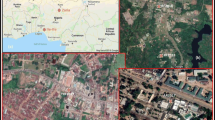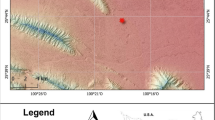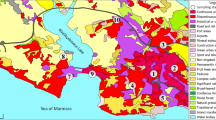Abstract
High concentrations of airborne asbestos in the ambient air are still a serious problem of air quality in numerous localities around the world. Since 2002, elevated concentrations of asbestos minerals of unknown origin have been detected in the ambient air of Pilsen, Czech Republic. To determine the asbestos fibre sources in this urban air, a systematic study was conducted. First, 14 bulk dust samples were collected in Pilsen at nine localities, and 6 bulk samples of construction aggregates for gravel production were collected in a quarry in the Pilsen-Litice district. The quarry is the largest quarry in the Pilsen region and the closest quarry to the built-up urban area. X-ray diffraction of the asbestos minerals revealed that monoclinic amphibole (MA, namely actinolite based on subsequent SEM-EDX analysis) in the bulk samples accounted for < 1–33% of the mass and that the highest values were found in the bulk dust samples from the railway platform of the Pilsen main railway station. Simultaneously, 24-h samples of airborne particulate matter (PM) at three localities in Pilsen were collected. Actinolite was identified in 40% of the PM samples. The relationship between the meteorology and presence of actinolite in the 24 PM10 samples was not proven, probably due to the long sampling integration time. Therefore, highly time-and-size-resolved PM sampling was performed. Second, sampling of size-segregated aerosols and measurements of the wind speed (WS), wind direction (WD), precipitation (P) and hourly PM10, PM2.5 and PM1 were conducted in a suburban locality near the quarry in two monthly highly time-resolved periods (30, 60, 120 min). Three/eight PM size fractions were sampled by a Davis Rotating-drum Uniform-size-cut Monitor (3/8DRUM) and analysed for the presences of asbestos fibres by scanning electron microscopy with energy dispersive x-ray spectroscopy (SEM-EDX). Asbestos fibre detection in highly time-resolved PM samples and current WD and WS determination allows the apportionment directionality of asbestos fibre sources. The number of critical actinolite asbestos fibres (length ≥ 5 μm and width < 3 μm, 3:1) increased with the PM1–10/PM10 and PM2.5–10/PM10 ratios, WS > 2 m s−1 and precipitation < 1 mm. Additionally, the number of critical actinolite asbestos fibres was not related to a specific WD. Therefore, we conclude that the sources of airborne critical actinolite asbestos fibres in Pilsen’s urban area are omnipresent. Frequent use of construction aggregates and gravel from the metamorphic spilite quarries in the Pilsen region and in many localities around the urban area is a plausible explanation for the omnipresence of the critical actinolite asbestos fibres concentration in Pilsen’s ambient air. Mitigation strategies to reduce the concentrations of critical actinolite asbestos fibres must be developed. Continuous monitoring and performing SEM-EDX analysis of highly time-and-size-resolved PM samples, correlated with fast changing WS and WD, seems to be a strong tool for efficiently controlling the mitigation strategies of critical actinolite asbestos fibres.


Similar content being viewed by others
References
Baumann F, Carbone M (2016) Environmental risk to mesothelioma in the United States: an emerging concern – epidemiological issues. J Toxicol Environ Health 19:231–249
Berman DW, Crump KS (2008) Update of potency factors for asbestos-related lung cancer and mesothelioma. Critical review Toxicity 38:1–47
Bloise A, Punturo R, Catalano M, Miriello D, Cirrincione R (2016) Naturally occurring asbestos (NOA) in rock and soil and relation with human activities: the monitoring example of selected sites in Calabria (southern Italy). Italian J Geoscience 135:268–279
Cahill C.F., 2003. Asian aerosol transport to Alaska during ACE-Asia. Journal of Geophysical Research 108 (D23):32, 1–8
Cahill TA, Goodart C, Nelson JW, Eldred RA, Nastrom JS, Feeney PJ (1985) Design and evaluation of the drum impactor. In: Ariman T, Veziroglu TN (eds) Proceedings of international symposium on particulate and multi-phase process, vol 2. Taylor and Francis, Philadelphia, pp 19–25
Case BW, Abraham JL (2008) Heterogeneity of exposure and attribution of mesotheliom: trend and strategies in two American countries. J Phys Conf Ser 151:1–15
Catherine H, Skinner W (2003) Mineralogy of asbestos minerals. Indoor Built Environ 12:385–389
Červenka, V., 2005. Zpráva o kontaminaci venkovního ovzduší amfibolovým azbestem z neznámého zdroje (Report of ambient air contamination via amphibole asbestos of unknown source), Foster Bohemia spol. s r.o., final report, Praha
Chlupáč I, Brzobohatý R, Kovanda J, Stráník Z (2002) Geologická minulost České republiky. Academia Praha, Czech, p 436
Davis, B.L., 1988. Reference intensity method of quantitative X-ray diffraction analysis, South Dakota School of Mines and Technology, Rapid City
Falzone L, Marconi A, Loreto C, Franco S, Spandidos DA, Libra M (2016) Occupational exposure to carcinogens: benzene, pesticides and fibers. Mol Med Rep 14:4467–4474
Fiala F (1977) Proterozoický vulkanismus Barrandienu a problematika spilitů. Sborník Geologických věd, Geologie 30:7–247 in Czech
Franck AL, Joshi TK (2014) The global spread of asbestos. Annals Global Health 80:257–262
Harper M (2008) 10th anniversary critical review: naturally occurring asbestos. J Environ Monit 10:1394–1408
Harris, K.E., Bunker, K.L., Strohmeier, B.R., Hoch, R., Lee, R.J., 2007. Discovering the true morphology of amphibole minerals: complementary TEM and FESEM characterization of particles in mixed mineral dust. In: Méndez-Vilas, a., Diaz, J., editors. Modern research and educational topics in microscopy, vol. 2. Formatex research center, Badajoz, Spain. ISBN-13: 978-84-611-9420-9
Hovorka J, Pokorná P, Hopke PK, Mikuška P, Křůmal K, Píšová M (2015) Wood combustion, a dominant source of winter aerosol in residential district in proximity to a large automobile factory in Central Europe. Atmos Environ 113:98–107
IARC, 2012. A review of human carcinogens: arsenic, metals, fibres, and dusts. IARC Monogr Eval Carcinogen Risks Hum 100C http://monographs.iarc.fr/ENG/Monographs/vol100C/index.php
IARC, 1977. Asbestos. IARC Monogr Eval Carcinog Risks Hum 14
ICDD, 2011. International Centre for diffraction data, powder diffraction file - release 2011, Pennsylvania
Larson TC, Vinicius C, Bove FJ (2010) Vermiculite worker mortality: estimated effect of occupational exposure to Libby amphibole. J Occup Environ Med 5:555–560
Luo S, Liu X, Mu S, Tsai SP, Wen CP (2003) Asbestos related diseases from environmental exposure to crocidolite in Da-Yao, China. Review of exposure and epidemiological data. Occup Environ Med 60:35–41 discussion 41–42
Ondruš, P., 1994: ZDS Software pro analýzu RTG práškových difrakčních záznamů, verze 5.14, Praha
Paoletti L, Batisti D, Bruno C, Di Paola M, Gianfana A, Mastrantonio M, Nesti M, Comba P (2000) Unusually high incidence of malignant pleura mesothelioma in a town of eastern Sicily: an epidemiological and environmental study. Archives of Environ Health 55:392–398
Peipins LA, Lewine M, Campolucci S, Lybarger JA, Miller A, Middleton D, Weis C, Spence M, Black B, Kapil V (2003) Radiographic abnormalities and exposure to asbestos-contaminated vermiculite in community of Libby, Montana, USA. Environ Health Perspect 14:1753–1759
Perkins RA, Hargesheimer J, Vaara L (2008) Evaluation of public and workers exposure due to naturally occurring asbestos in gravel discovered during a road construction project. J Occup Environ Hyg 5:609–616
Pokorná P, Hovorka J, Kroužek J, Hopke PK (2013) Particulate matter source apportionment in a village situated in industrial region of Central Europe. J Air Waste Manage Assoc 63:1412–1421
Pokorná P, Hovorka J, Hopke PK (2016a) Elemental composition and source identification of very fine aerosol particles in a European air pollution hot-spot. Atmospheric Pollution Res 7:671–679
Pokorná P., Hovorka J., Brejcha J., 2016b. Impact of mining activities on the air quality in the village nearby a coal strip mine, IOP Conf. Series: Earth Environ Sci, 44, 032021
Roggli VL (2015) The so-called short-fiber controversy. Arch Pathol Lab Med 139:1052–1057
Sakai K, Hisanaga N, Kohyama N, Shibata E, Takeuchi Y (2001) Airborne fiber concentration and size distribution of mineral fibers in area with serpentinite outcrops in Aichi prefecture, Japan. Ind Health 39:132–140
Scherbakov, S. V., Kashansky, S., Domnin, S.G., Kogan, F.M., Kozlov, V. Kochelayev, V.A., Nolan, R. P. in: The Health Effects of Chrysotile Asbestos: Contribution of Science to Risk Management Decisions, eds. Nolan, R. P., Langer, A. M., Ross, M., Wicks, F. J., Martin, R. F., 2001. Mineralogical Association of Canada, Canadian Special Publication 5, 187–198
Stayner L, Welch LS, Lemen R (2013) The worldwide pandemic asbestos-related diseases. Annual Rev Public Health 34:4.1–4.12
Strohmeier BR, Huntington JC, Bunker KL, Sanchez MS, Allison K, Lee RJ (2010) What is asbestos and why is it important? Challenges of defining and characterizing asbestos. Int Geol Rev 52:801–872
Sullivan PA (2007) Vermiculite, respiratory, disease, and asbestos exposure in Libby, Montana: update of a cohort mortality study. Environ Health Perspect 4:579–585
Swayze GA, Kokaly RF, Higgins CT, Clinkenbreard JP, Clark RN, Lowers HA, Sutley SJ (2009) Mapping potentially asbestos-bearing rocks using imaging spectroscopy. Geological Soc Am 37:763–766
White N, Nelson G, Murray J (2007) South African experience with asbestos related environmental mesothelioma: is asbestos fiber type important? Regul Toxicol Pharmacol 52:S92–S96
World Health Organisation (WHO), 2000. Air quality guidelines for Europe. Second edition. WHO Regional publications, European Series, No. 91
World Health Organisation (WHO), 2010. Asbestos: elimination of asbestos-related diseases. Fact sheet N 343, July. http://www.who.int/mediacentre/factsheets/fs343/en/index.html
Wylie A, Candela P (2015) Methodologies for determining the sources, characteristics, distribution and abundance of asbestiform and nonasbestiform amphibole and serpentine in ambient air and water. J Toxicology Environ Health, Part B 18:1–42
Zachariáš, J., 2009. Mineralogická charakteristika vzorků kameniva (mineralogical characteristic of the bulk samples), study, Institute of Geochemistry, Mineralogy and Mineral Resources, Faculty of Science, Charles University
Acknowledgement
The authors acknowledge the Czech Hydrometeorological Institute Branch, Pilsen, for their cooperation during the measurements and data provision.
Funding
This work was supported by grant no P503/12/G147 of the Czech Science Foundation and by the Environmental Fund of Pilsen.
Author information
Authors and Affiliations
Corresponding author
Additional information
Responsible editor: Gerhard Lammel
Highlights
• The development and test of a new method for fibres monitoring with high time resolution.
• Detection of actinolite asbestos in highly time-resolved urban PM, regardless of the wind direction, points to use of gravel in local roads/pathways.
• Increases in the number of actinolite asbestos fibres in PM with a high proportion of coarse PM and wind speed but low precipitation confirms the fugitive actinolite asbestos fibre sources.
• Week-long unattended highly time-resolved PM sampling and detection of asbestos minerals are suitable for evaluating the effectiveness of mitigation strategies.
Electronic supplementary material
ESM 1
(DOCX 4086 kb)
Rights and permissions
About this article
Cite this article
Klán, M., Pokorná, P., Havlíček, D. et al. New comprehensive approach for airborne asbestos characterisation and monitoring. Environ Sci Pollut Res 25, 30488–30496 (2018). https://doi.org/10.1007/s11356-018-2791-7
Received:
Accepted:
Published:
Issue Date:
DOI: https://doi.org/10.1007/s11356-018-2791-7




